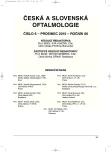Deep Perforating Trabeculectomy – Results after up to Six Years Follow-Up
Authors:
P. Krist 1; E. Fric 1; S. Al Marei 1; J. Zapletalová 2
Authors‘ workplace:
Oční oddělení Nemocnice, Kyjov, primář MUDr. Fric E., Ph. D.
1; Ústav lékařské biofyziky Lékařská fakulta Univerzita Palackého, Olomouc, přednostka doc. RNDr. Hana Kolářová, CSc.
2
Published in:
Čes. a slov. Oftal., 66, 2010, No. 6, p. 262-265
Category:
Original Article
Overview
Aim:
The aim of this retrospective study was to establish intraocular pressure (IOP) values in patients after deep perforating trabeculectomy (TE) in time periods after the surgery (one month, 3 months, 1 year, 3 years, and 6 years). Furthermore, the pharmacotherapy after TE and complications after TE, especially consecutive cataract surgeries, were followed-up.
Material and methods:
Altogether 110 patients were included into the study, which underwent TE in the years 2003 – 2008 at the Department of Ophthalmology, Kyjov Hospital, Czech republic. The TE procedure was performed in the standard manner with the base of the conjunctival flap located at the limbus. The non-parametric Wilcoxon pair test was used for the statistical evaluation.
Results:
In all time periods after the surgeries, statistically significant decrease of the IOP comparing to the preoperative values occurred (test significance p < 0.0001 for all comparisons). The pharmacotherapy after the TE was reduced significantly: after 6 years, there were 27 % of patients without any therapy, 39 % of patients used the neuroprotective monotherapy only, 32 % used combined therapy with two medications, and two patients only were treated by combined therapy with three medications. In two patients in which the target IOP was not reached, another TE was performed and the target IOP was achieved.
Conclusions:
TE is safe and effective method in the glaucoma therapy. After 6 years, two thirds of patients are without any therapy, or with neuroprotective monotherapy respectively.
Key words:
Glaucoma, deep perforating trabeculectomy, target intraocular pressure
Sources
1. Bayer, Au., Erb, C., Ferrari, F. et al.: The Tübingen Glaucoma Study. Glaucoma filtering surgery- a retrospective long-term follow up of 254 eyes with glaucoma. Ger J Ophthalmol, 1995, 4: 289–93.
2. Edmunds, B., Thompson, Jr., Salmon, Jf. et al.: The national survey of trabeculectomy. II. Variations in operative technique and outcome. Eye 2001, 15: 441-448.
3. Hornová, J., Nováková, D.: Sledování nitroočního tlaku a léčby po dobu dvou let po trabekulektomii na obou očích. Čes Slov Oftalmol. 2001, 57: 408–413.
4. Kanski, J.: Clinical Ophthalmology. IV. Edition, Butterworth-Heinemann International Editions, 1999, s. 183-262, ISBN 0-7506-4014-6.
5. Kolektiv autorů Oční kliniky 1. LF UK a ÚVN v Praze: Glaukom-vybrané kapitoly, Nucleus HK, Hradec Králové, 2008, s. 228, ISBN 978-80-87009-35-2.
6. Koršić, J., Novak-Lauš, K., Mandić Z.: Trabeculectomy-long term effects. Acta clin Croat 2002, 41 (Suppl 4): 63–66.
7. Kraus, H., Karel, I., Růžičková, E.: Oční zákaly. Grada, Praha, 2006, s. 149, ISBN 80-7169-967-5.
8. Novák, J., Hovorková, M., Rozsíval, P. et al.: Použití 5-fluorouracilu u trabekulektomie. Čes Slov Oftalmol 2000, 56: 376–384.
9. Růžičková, E. Glaukom –minimum pro praxi, Triton, Praha, 2000, s. 110, ISBN 80-7254-120-X
10. Wilensky, Jt.,Chen, Tc.: Long-term results of trabeculectomy in eyes that were initially successful. Trans Am Ophthalmol Soc 1996: 147–159.
Labels
OphthalmologyArticle was published in
Czech and Slovak Ophthalmology

2010 Issue 6
Most read in this issue
- Corneal Higher Order Aberrations and their Changes with Aging
- Corneal Cross-linking – Modern Method of Keratoconus Treatment
- Deep Perforating Trabeculectomy – Results after up to Six Years Follow-Up
- Improvement in the Outcome of Visual Impairment using Low Vision Aids in Children
